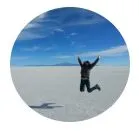Wondering what to do in Cusco Peru? If you are travelling to Peru, you should definitely visit Cusco, the capital of the Inca Empire. Evidence of Inca culture is everywhere in this fascinating city, and it is the base for most people going to Machu Picchu. However, before attempting the trek to Machu Picchu, I highly recommend spending at least a couple of days in Cusco to explore and acclimatize to the altitude. To help you plan the perfect Cusco itinerary, I’ve put together my recommendations for spending 2 days in Cusco to experience the culture, food and history.
The Best Things to Do in Cusco in 2 Days
Cusco is also known as the bellybutton of the world, and while that doesn’t sound very appetising there is plenty to do in this amazing city. 2 days in Cusco is enough to see the highlights without rushing around, yet if you have more time you could easily spend more time in Cusco and not get bored.
If you do have a couple more days to spend in Cusco, you can also explore the rest of the Sacred Valley and take some day trips from Cusco or stay overnight in other towns such as Pisac or Ollantaytambo to properly explore.
Know Before You Go to Cusco
Before travelling to Cusco, make sure you book accommodation and popular activities ASAP as hotels and tickets can sell out.
🛌 MY FAVOURITE ACCOMMODATION IN CUSCO:
$$ Katari at Plaza de Armas Cusco right in the centre of Cusco & great value
$$ Casa Matara – a beautifully furnished boutique hotel
$ Casa Tunki – A gorgeous hotel & hostel with pretty courtyard
⭐ TOP 3 CUSCO ACTIVITIES TO BOOK IN ADVANCE:
1. Cusco: Rainbow Mountain Day Trip and Red Valley
Cusco Itinerary Day 1
Cusco City Tour
A great way to explore without over-exerting yourself as you get used to the altitude is with a Cusco city tour. If you are feeling up to it, a walking tour of Cusco will take around three hours, and you can visit all the key sites in the city.
If you prefer not to walk around too much, then a bus tour may be better for you, which will include some walking around the narrow streets in the city but will also include trips to the nearby Inca sites of Sacsayhuaman, and usually Qenqo as well.
Check out these tours of Cusco:
If you prefer not to take a Cusco city tour and simply explore by yourself, these are the main attractions to include in your Cusco itinerary.
San Pedro Market in Cusco
I usually make a beeline for the markets in any city, and Cusco is no different. San Pedro Market is a bustling local market where you can pick up super cheap local food, as well as llama jumpers, souvenirs and snacks for the treks you will probably be doing in the next few days.
Alternatively, just wander around and absorb the sights and smells of the market, as the local people go about their business side by side with the tourists.
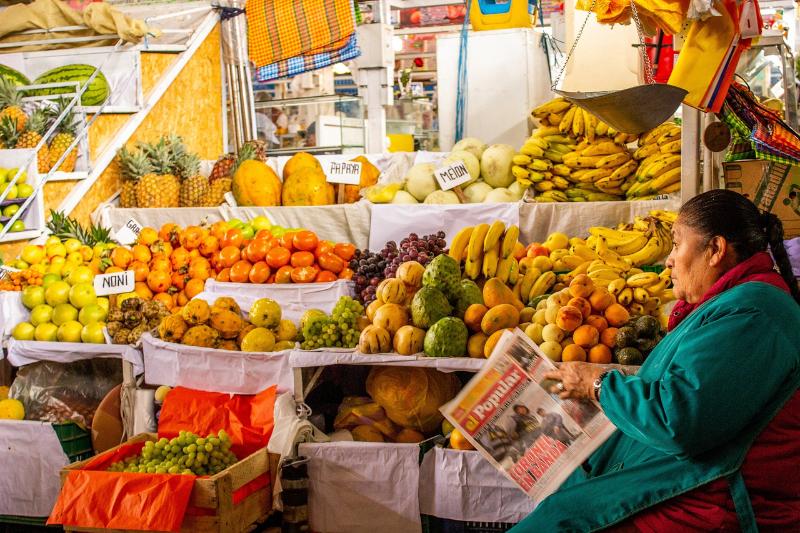
Cusco Cathedral & Plaza de Armas
The main square in Cusco is the huge Plaza de Armas. It is always busy with people selling all kinds of stuff, shoe-shiners, tourists and locals milling about. It also has a historical significance as the centre of the Inca Empire, and the place where the last Inca was executed.
The Cathedral dominates the plaza, and you can take a look inside if it is open, or even attend mass there. The other impressive-looking building is the Natural History Museum, which is better appreciated from the outside, to be honest!
YOU MAY ALSO LIKE: Solo Travel in Peru: A Guide to Travelling in Peru Alone
The 12 Angled Stone
A stone might not sound that impressive at first, but what makes this stone so special is that it demonstrates the skill of Inca masonry, who managed to fit together huge stones to build houses, temples and entire cities without the use of mortar.
They found this stone with 12 angles to fit exactly into place in the wall which is actually very impressive! There are plenty of locals asking for a couple of soles to show you where it is, but you’ll find it easily enough due to the crowd of people taking photographs.
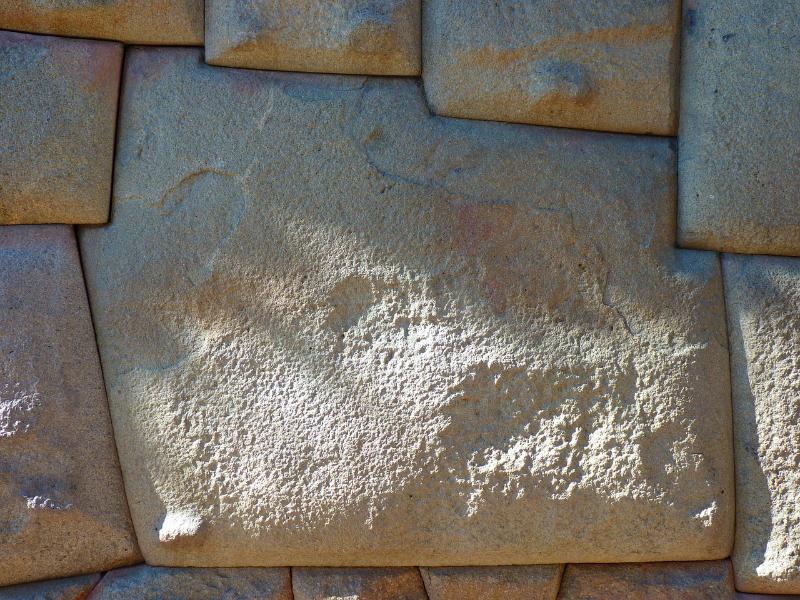
Quirkancha Temple
The Quirkancha or Qorikancha Temple was the most important temple in the Incan Empire. It was covered in gold until the Spanish conquistadors destroyed it, taking the gold and using the stones to build the Santo Domingo Church on the foundations of the temple.
The temple is worth going in, even though it isn’t included in the tourist ticket, and the gardens are beautiful. There is a small museum close by, which houses some of the original artefacts, but it was disappointing.
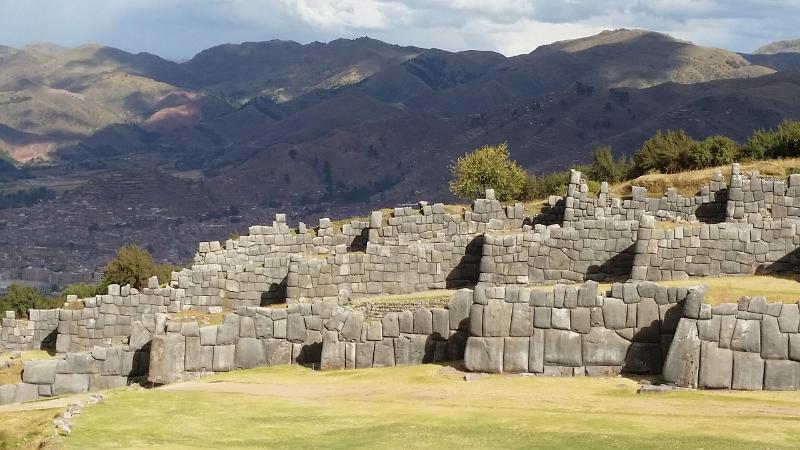
Sacsayhuaman
Outside of the centre of Cusco, Sacsayhuaman (we pronounced it Sexy Woman, as I’m sure all English speakers do) is an impressive Inca site, a short taxi journey or 30-minute walk uphill from the Plaza de Armas.
The huge fortress was constructed at the head of the puma shape that Cusco is designed around. Its Quechua name means ‘satisfied falcon’, and it proudly overlooked the city below.
The huge walls surrounding the fortress are constructed from immense blocks of stone, fitted together with absolute precision. The Spanish used the smaller stones to build their colonial town, so only the larger rocks remain in place today and have been strong enough to withstand several earthquakes which rocked Cusco over the years.
In the centre of the site lies a huge plaza, still used today for performances and celebrations such as the Inti Raymi Festival of the Sun, a theatrical reconstruction of the religious ceremony the Inca performed on the winter solstice, which takes place on 24th June.
The Boleto Turistico Tourist Ticket
The Boleto Turistico or Cusco tourist ticket allows access to 16 different Inca ruins and museums in & around Cusco and is valid for 10 days.
The city centre inclusions on the ticket, I have to say, weren’t the most impressive attractions I’ve ever visited. But they are free with the ticket, so some are worth visiting if you have the time.
You will need to buy the ticket to visit Sacsayhuaman and other sites in the Sacred Valley like Pisac, Moray and Ollantaytambo, among others.
I think you should be able to manage all of the above in just one day, but if you are suffering from altitude sickness then don’t push yourself too hard.
Instead of going to Sacsayhuaman on your first day in Cusco, you could save it for your second day, and spend the rest of the afternoon relaxing or perhaps doing some of the activities I’ve suggested for your second day.
Cusco is not the place to rush around, especially if you have just arrived in Peru!
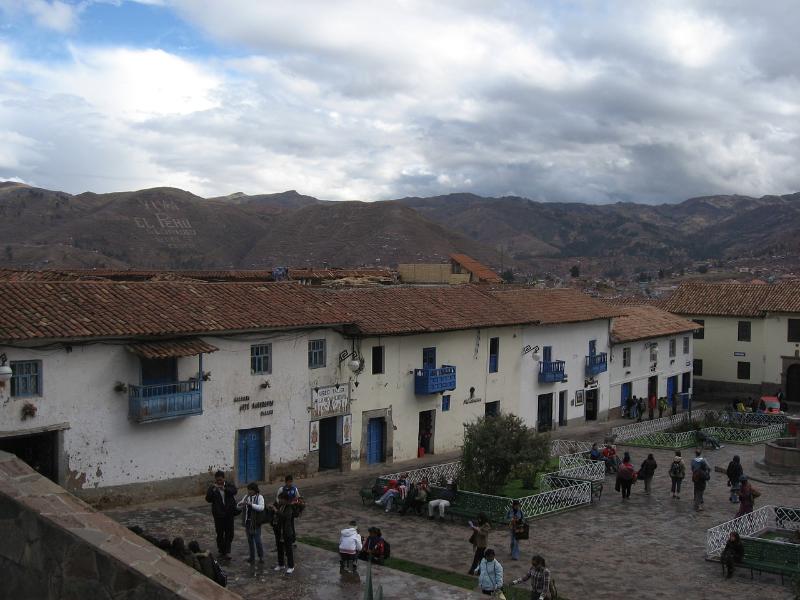
Cusco Itinerary Day 2
Explore San Blas
San Blas is a quieter neighbourhood up the hill from the hustle and bustle of the city centre. It has a more artsy feel and has art galleries and local artisans who produce beautiful crafts.
San Blas Market is smaller and cleaner than San Pedro Market and is a much more local affair where you can grab a bite to eat. Simply walking around San Blas is a joy, where the narrow, cobbled streets and pretty church square feel much more like the ‘real’ Peru than the rest of Cusco.
Shop for Souvenirs
Cusco is full of markets and stalls where you can buy last-minute items for your trek to Machu Picchu, or souvenirs so you can take fond memories of Peru back home with you.
Peruvian wool sweaters, hats and scarves are some of the most popular souvenirs as they are practical too! Alpaca wool is the softest and usually the most expensive wool you can buy (except for the luxury vicuña wool). If you find a great price for alpaca wool, it is probably too good to be true!
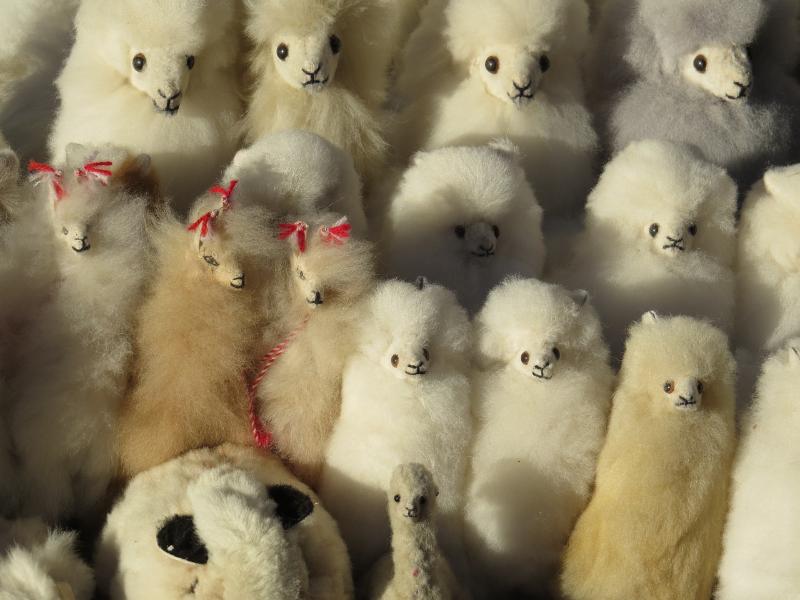
Foodie Things to do in Cusco
For me, food is such an important part of culture that I always try to eat as much local food as possible. Cusco is no different and has a variety of things to do to allow you to explore the city and the delicious Peruvian cuisine.
YOU MAY ALSO LIKE: Peru Food Guide – What to Eat in Peru
The Choco Museo
The chocolate museum is a free museum area where you can learn about the chocolate-making process. It also has a shop filled with tasty chocolate products, and the chance to take chocolate making classes.
Cooking Classes in Cusco
I LOVE cooking classes! You can take a cooking class in Cusco to learn more about the local cuisine, markets and eat delicious Peruvian food. Yum!
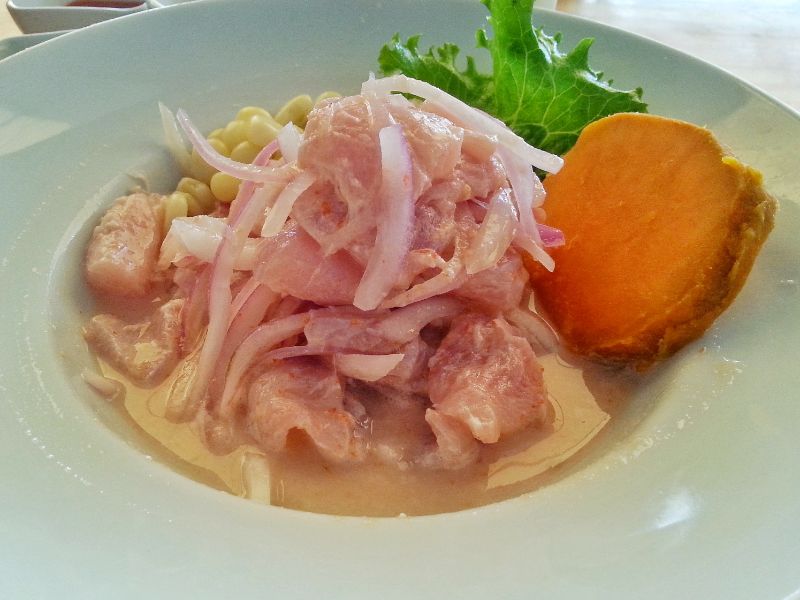
A Cusco Food Tour
Food tours are another great way to taste local cuisine, safe in the knowledge that you are trying the best, tastiest food on offer. Marcelo Batata’s Culinary tour gets great reviews, and you can try traditional Peruvian food like anticuchos (beef heart skewers) and Peruvian doughnuts.
Cusco Itinerary: Things to do in Cusco at Night
If you are not exhausted from spending 2 days in Cusco sightseeing and exploring, you may want to get out and about in the evening and enjoy Cusco by night. There are plenty of restaurants, bars and clubs in Cusco, but remember that alcohol makes the effects of altitude sickness much worse, so if you already have a headache from the altitude, lay off the booze.
However, a pisco sour is a traditional Peruvian cocktail, so I recommend trying one if you feel up to it! You could even take an evening tour and pisco-sour-making class too!

Alternatively, star-gazers might prefer this planetarium visit with a night tour and dinner.
If you bought the Cusco Tourist Ticket to visit Sacsayhuman, you could consider a visit to the Centro Qosqo de Arte Nativo (The Qosqo Centre for Native Art). In the evening at 7pm, the Centro Qosqo de Arte Nativo has a performance of traditional music & dance, although there are often queues so aim to arrive by 6.30pm.
I have to admit that Peruvian singing is pretty bad but the music & dances were interesting, although sometimes repetitive. Reading reviews of the performance, some people think it lacks professionalism, but I enjoyed it, and considering it is for free and for an hour I thought it was worth a visit.
Day Trips from Cusco
Machu Picchu
I couldn’t have an article about Cusco and not mention Machu Picchu, although I would not include it in your 2-day Cusco itinerary.
Cusco is the usual stop-off point for people beginning the Inca Trail or one of the other treks to Machu Picchu. However, trekking isn’t the only way to get to Machu Picchu, it is also possible to take the train from Cusco or Ollantaytambo to Aguas Calientes, the town at the base of Machu Picchu mountain.
It is possible to visit Machu Picchu on a day tour from Cusco; however, I recommend spending the night in Aguas Calientes so you can be up early to visit Machu Picchu for sunrise. Machu Picchu should not be rushed!
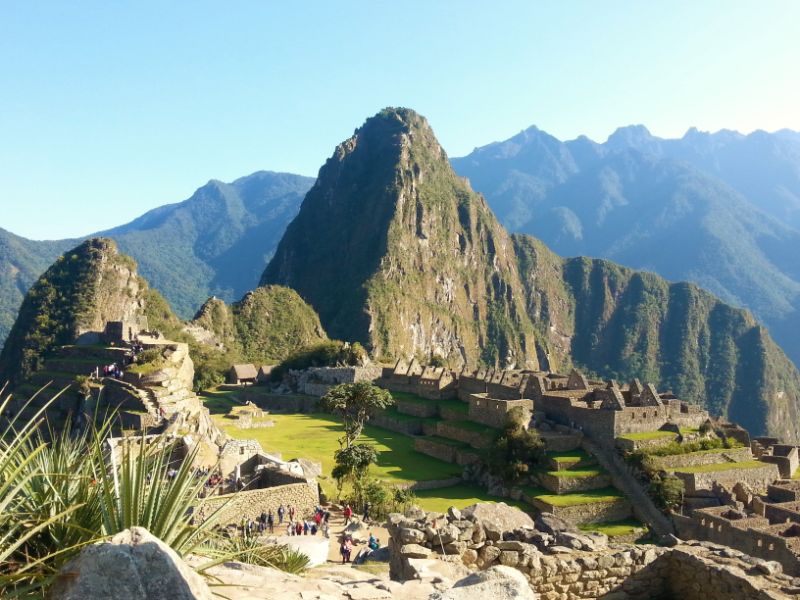
Explore the Sacred Valley
Cusco is a wonderful base to explore the rest of the Sacred Valley, either on day trips from Cusco or to travel around and spend a couple of nights in each place. Read more about day trips from Cusco here.
Sacred Valley day tours from Cusco typically include Chinchero, Maras and Moray which can be visited easily in a day, Pisac which can be done as a day tour or overnight stop, and Ollantaytambo which is often visited on the way to Machu Picchu as it is between Cusco and Machu Picchu.
The most popular day trip from Cusco is to visit the salt mines at Maras, the circular Inca terraces at Moray and the weaving communities at Chinchero. If you only have 2 days to spend in the whole of the Sacred Valley, I would then spend one day in Cusco, and the second day doing this tour.
However, I definitely recommend spending more time in the region so you can enjoy it properly without rushing.
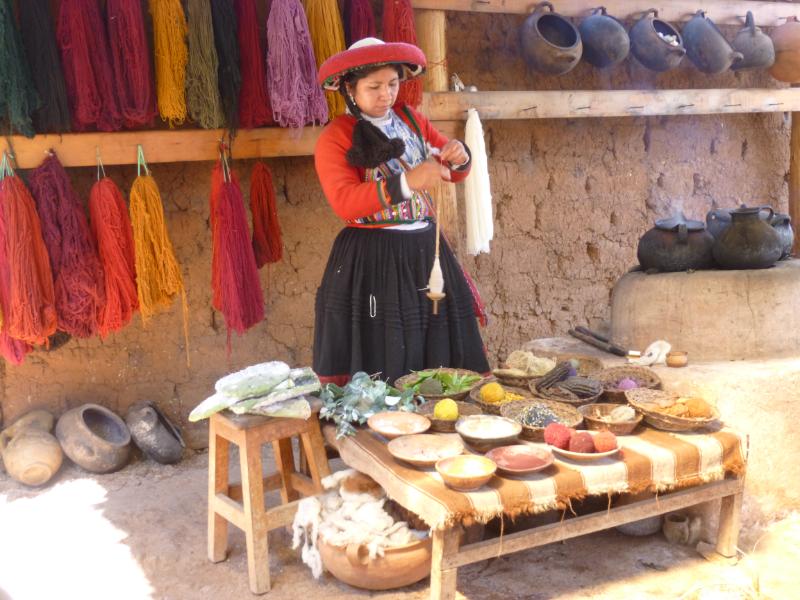
Useful Information for your Cusco Itinerary
Altitude Sickness in Cusco
The altitude in Cusco can hit you hard. Cusco sits at an elevation of 3,399 m (11,152 ft) above sea-level, and visitors who arrive straight to Cusco from lower altitudes often suffer from altitude sickness.
If you only have 2 days in Cusco, take it easy and don’t over-exert yourself. Even climbing a flight of stairs can be a challenge when you first arrive!
If you have a headache, take paracetamol to ease it, keep hydrated and avoid alcohol and smoking. Chewing coca leaves or drinking coca tea will also relieve symptoms.
If you suffer from any more serious symptoms like vomiting and disorientation, seek medical attention immediately as severe altitude sickness can be fatal.
Is Cusco Safe?
Yes, as long as you listen to your body, act quickly if you have altitude sickness, and follow any normal safety tips.
As one of the most popular destinations in South America for tourists, Cusco was one of the safest places I visited in my 10-month South America backpacking trip. However, be wary at night as you would anywhere else, and avoid walking around alone on your own.
Pickpocketing is common in busy areas like the Plaza de Armas and San Pedro Market, but wherever you are in the city make sure you keep a close eye on your belongings. Only take official taxis, which are safer than flagging down one in the street.
Be especially careful in and around the bus station, where thieves target tired & disorientated tourists who have just arrived.
If you are travelling in Peru alone, check out this Peru Solo Travel Guide.

Travel Safely
- Leave valuables at home and don't keep all your money and credit cards in one place. I love hidden pocket clothing like this travel scarf for stashing my cash and passport or a belt with a hidden pocket. Read more about how to hide money while travelling.
- Bring a water bottle with a built-in filter so you can safely drink water from any fresh water source while saving money and reducing plastic use. I take my Water-to-Go bottle with me everywhere!
- Unfortunately, things can and do go wrong when you travel. I always buy travel insurance and was very glad I had insurance when I had my laptop and passport stolen in Ecuador! Consider getting insurance for your trip to cover things like trip cancellation, emergency medical, lost luggage and stolen items, as well as adventure sports and activities and more.
- I chose World Nomads Travel Insurance for my recent backpacking trip to Australia and New Zealand. They offer travel insurance for independent travellers and intrepid families and you can get a quote, make a claim, or buy or extend your policy while on the road
As an affiliate, I receive a fee when you get a quote from World Nomads using this link. I do not represent World Nomads. This is information only and not a recommendation to buy travel insurance.
Where to Stay in Cusco
Most of the tourist activity in Cusco is centred around la Plaza de Armas, which is also where our group stayed on my first visit to Cusco.
It is a good practical base as there are plenty of bars & restaurants to choose from, and tons of trekking equipment shops, tour companies and pharmacies to stock up on insect repellent and plasters for the trek. However, it tends to be busier and noisy at times.
If you prefer to have a little more authentic experience, the quieter San Blas neighbourhood is much less in your face and has a more artsy feel to it. The area is pretty with narrow cobbled streets and much quieter than the centre, but anywhere away from the Plaza de Armas involves walking up a steep hill which can be challenging with heavy bags!
The Best Hostels in Cusco
There are a dizzying number of hostels in Cusco to choose from, but these are some of the best Cusco hostels for backpackers and budget travellers.
La Wak’a Perdida Hostel
La Wak’a Perdida is a small new hostel which only has one 8 bed dorm and a double room, so is cosy and quiet. The owner is friendly, and breakfast is included in the rate or there is a kitchen to cook your own food. It’s about 15 minutes’ walk from the Plaza de Armas, close to San Blas. BOOK NOW>>>
Pariwana Hostel Cusco
Pariwana Hostel is a very popular Cusco Hostel, and is a sociable place with a bar and large terrace area for ping pong and socialising. It is a borderline party place, but at the same time not crazy so you can still sleep.
Breakfast is included, there is no kitchen but you can order food at the bar if you don’t fancy going out to eat. Private rooms and dorms are available. Very central, a couple of blocks from Plaza de Armas. BOOK NOW>>>
Hospedaje Turistico Recoleta
Hospedaje Turistico Recoleta is small and homely hostel with great reviews for being a lovely place to relax and chill before or after the trek to Machu Picchu! >>>BOOK NOW
Kokopelli Hostel Cusco
Kokopelli Hostel Cusco is THE place to stay in Cusco if you want to party but still with a comfy bed in a decent dorm room. >>>BOOK NOW
Cusco Hotels
There is no shortage of hotels in Cusco either, from luxury properties to family-run guesthouses. Check out the ratings for all Cusco Hotels on Booking.com or check out my top picks for Cusco hotels:
Antigua Casona San Blas
Antigua Casona San Blas is a 4* boutique hotel in the San Blas neighbourhood, which gets rave reviews for the friendly staff, excellent service and well-appointed rooms. San Blas is up a steep hill from Plaza de Armas so it isn’t ideal if you have mobility issues. >>>CHECK PRICES & AVAILABILITY
Katari at Plaza de Armas Cusco
The location of Katari at Plaza de Armas Cusco can’t be beaten – it is on the corner of the Plaza de Armas right in the centre of Cusco. Guests love the location, staff and comfort but the free wifi isn’t the best. >>>CHECK PRICES & AVAILABILITY
Casa Matara Boutique
Another lovely boutique hotel, the family-owned Casa Matara is beautifully furnished with a blend of modern and traditional Peruvian decor. The comfortable beds and spacious bedrooms, and it’s just a 9 minute walk from Plaza de Armas. >>>CHECK PRICES & AVAILABILITY
Airbnb in Cusco
There are also plenty of options on Airbnb, like this charming apartment in the city centre, or check out the range of apartments on Booking.com, which often have better cancellation terms than Airbnbs in Cusco.
Where to Eat in Cusco
San Pedro Market
I love poking around local markets for tasty treats, and the street food stalls outside the market are great places to get some cheap food.
However, if you have just arrived in Peru, your stomach might not be ready for street food, so it may be best to opt for a ‘safer’ choice, especially if you are planning to do the Inca Trail or other hikes in the next few days.

Restaurants in Cusco
If you are feeling the effects of altitude, eating light meals will help your stomach to digest the food more easily.
Good restaurants to try in Cusco include Mr Soup, which has a range of delicious soups (including a couple of veggie options), and vegetarian-friendly restaurants like Green Point Vegan Restaurant and Organika.
Restaurants around the Plaza de Armas tend to be more expensive as they are tourist hotspots. I treated myself to a meal at the Inka Grill, which was pricey, but delicious, and a luxurious treat after the trek. Trout ceviche and alpaca steak with a pisco sour all went down really well!
I loved the lomo saltado at Morena Peruvian Kitchen, which serves Peruvian food with a modern twist at mid-range prices.
If you’re craving some food from home, Jack’s Café serves up an awesome breakfast/brunch menu and old favourites like burgers and nachos.
How to Get to Cusco
Flights to Cusco Peru
You can fly into Cusco airport from Lima and a couple of international destinations such as La Paz Bolivia or Bogota Colombia. Most international flights will involve a change in Lima. Check Skyscanner for the best flight deals to Cusco.
Once you’ve collected your baggage, I’d suggest taking an official taxi from the airport to wherever you’re staying or arranging an airport transfer. There have been reports of muggings and problems with fake taxi scams taking advantage of weary travellers, so be on your guard.
Bear in mind that flying into Cusco from a lower elevation is more likely to cause problems with altitude sickness than slowly increasing the altitude and arriving by land. Take it easy as you acclimatise to the altitude in Cusco!
Buses to Cusco
If you are already in Peru, travelling to Cusco by bus is a good option. There are regular buses from Lima, Arequipa, Puno and La Paz, although the journeys are very long.
However, if you choose a decent bus service, they are good value and safe. For the bus from Lima to Cusco, I recommend stopping off along the way to explore more of Peru.
I did this travelling with Peru Hop, as you can hop on and hop off the bus service at several different destinations along the way – including Huacachina, Paracas, Nazca and Arequipa, as well as Lake Titicaca if you choose that particular route.

If you are short on time or prefer to travel independently, then Cruz del Sur is the most reliable long-distance bus company in Peru, although there are plenty of others.
They have their own Cruz del Sur terminal in Cusco which is about 10 minutes’ walk to the bus station which most other companies use. You can take a taxi from the terminal to your accommodation, check with the accommodation for an estimate of prices so you don’t get ripped off, or ask them to arrange a transfer for you.
If you are travelling on a different bus line such as Oltursa, Civa or Tepsa, you will arrive at the main Cusco Bus Terminal. Cusco bus station (called the Terminal Terrestre) is about 30 minutes’ walk from the main square in Cusco, so you will probably need to take a taxi to where you are staying.
Make sure you take an official taxi and agree on the price before you get in.
Bus from La Paz to Cusco
If you are travelling from La Paz in Bolivia, Bolivia Hop run a similar service to Peru Hop, or you can just go to the bus station in La Paz and buy a ticket on any bus service to Cusco.
Some of the bus routes go via Copacabana and Puno so you can visit Lake Titicaca along the way, however, some routes go a different way so double check before you buy. If you’d like to spend some time at Lake Titicaca, you could also consider a more comfortable bus ride to Puno.
Trains to Cusco
I would have loved to take the train from Lima to Cusco, but unfortunately trains in Peru are not very common! The train line to Machu Picchu starts at Cusco, and there are no trains from Cusco to Lima so you will need to take the bus or fly to Cusco.

What do you think of this Cusco itinerary? How would you spend your 2 days in Cusco? I’d love to hear your thoughts, please leave your comments below.
